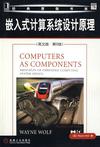嵌入式计算系统设计原理
出版时间:2009-1 出版社:机械工业出版社 作者:沃尔夫 页数:507
前言
Embedded computing is more important today than it was in 2000.when the first edition of this book appeared.Embedded processors are in even more products,ranging from toys tO airplanes.Systems-on-chips now use up to hundreds of CPUs.The cell phone is on its way to becoming the new standard computing platform.As my column in IEEE Computer in September 2006 indicated.there are at least a half-million embedded systems programmers in the World today,probably closer to 800,000.In mis edition I have tried to both update and revamp.One major change is mat the book now uses the TI TMS320C55xTM(C55x)DSP.I seriously rewrote the discussion of real-time scheduling.I have tried to expand on performance analysis as a theme at as many levels of abstraction as possible.Given the importance of multiorocessors in even the most mundane embedded systems,this edition also talks more genetaUy about hardware/software co-design and muItiorocessors.One ofthe changes in the field is that this material iS taught at lower and lowerlevels of the curriculum.What used to be graduate material is now upper-division undergraduate;some of this material Will percolate down to the sophomore levelin the foreseeable future.I think that you Can use subsets of this book tO cover both more advanced and more basic courses.Some advanced students may not need the background material of the earlier chapters and you Can spend more time on software performance analysis,scheduling,and multiprocessors.Vc'hen teaching introductory courses,software performance analysis is an alternative path to exploroing microprocessor architectures as well as software;such courses can concentrate on the first few chapters.The new Web site for this book and my other books is http://www.waynewolf.us.On this site,yoU can find overheads for the material in this book,suggestions for labs.and links tO more information on embedded systems.
内容概要
本书从组件技术的视角出发,介绍了嵌入式系统设计技术和技巧。本书第l版已被广泛应用于教学,可以说在很大程度上引发了嵌入式系统课程的创立,并为实践设计提供了宝贵指南。第2版根据最先进的技术发展进行了更新。不论是进行软硬件设计的研究人员、学生还是专家,都能从Wayne Wolf的集成化工程设计方法中获益匪浅。 本书主要特点: 以实际芯片(ARM芯片和TI C55x DSP)为例,进行相关设计技术和技巧的说明,向读者介绍如何将这些理论付诸于设计实践。 在所有关键课题讨论中都尤为强调现实中的设计实践,从而为学生和设计人员提供了最先进技术的指导。 对设计实践中所必需的基本应用技术进行重点讨论,帮助读者在实际工作中熟练地设计大型的、复杂的嵌入式系统。
作者简介
Wayne Wolf,拥有斯坦福大学电气工程博士学位,曾执教于普林斯顿大学,现任职于GeorgiaTech公司。在1989年加入普林斯顿大学之前,他曾在AT&T贝尔实验室工作。他是IEEE和ACM会员、IEEE计算机协会核心成员以及ASEE和SPIE成员。Wolf教授于2003年获得TASEE Frederick E.Ter
书籍目录
About the AuthorForeword to The First EditionPreface to The Second EditionPreface to The First EditionList of ExamplesCHAPTER 1 Embedded Computing Introduction 1.1 Complex Systems and Microprocessors 1.1.1 Embedding Computers 1.1.2 Characteristics of Embedded Computing Applications 1.1.3 Why Use Microprocessors? 1.1.4 The Physics of Software 1.1.5 Challenges in Embedded Computing System Design 1.1.6 Performance in Embedded Computing 1.2 The Embedded System Design Process 1.2.1 Requirements 1.2.2 Specification 1.2.3 Architecture Design 1.2.4 Designing Hardware and Software Components 1.2.5 System Integration 1.3 Formalisms for System Design 1.3.1 Structural Description 1.3.2 Behavioral Description 1.4 ModelTrain Controller 1.4.1 Requirements 1.4.2 DCC 1.4.3 Conceptual Specification 1.4.4 Detailed Specification 1.4.5 Lessons Learned : |.5 A Guided Tour of This Book 1.5.1 Chapter 2: Instruction Sets 1.5.2 Chapter 3:CPUs 1.5.3 Chapter 4: Bus-Based Computer Systems 1.5.4 Chapter 5: Program Design and Analysis 1.5.5 Chapter 6: Processes and Operating Systems.. 1.5.6 Chapter 7: Multiprocessors 1.5.7 Chapter 8: Networks 1.5.8 Chapter 9: System Design Techniques Summary Further Reading Questions Lab ExercisesCHAPTER 2 Instruction Sets Introducton 2.1 Preliminaries 2.1.1 ComputerArchitecture Taxonomy 2.1.2 Assembly Language 2.2 ARM Processor 2.2.1 Processor and Memory Organization 2.2.2 Data Operations 2.2.3 Flow of Control 2.3 TI C55x DSP 2.3.1 Processor and Memory Organization 2.3.2 Addressing Modes 2.3.3 Data Operations 2.3.4 Flow of Control 2.3.5 C Coding Guidelines Summary Further Reading Questions Lab ExercisesCHAPTER 3 CPUs Introduction 3.1 Programming Input and Output 3.1.1 Input and Output Devices 3.1.2 Input and Output Primitives 3.1.3 Busy-Wait I/O 3.1.4 Interrupts 3.2 Supervisor Mode, Exceptions, and Traps 3.2.1 Supervisor Mode 3.2.2 Exceptions 3.2.3 Traps 3.3 Co-Processors ……CHAPTER 4 Bus-Based Computer SystemsCHAPTER 5 Program Design and AnalysisCHAPTER 6 Processes and Operating SystemsCHAPTER 7 MultiprocessorsCHAPTER 8 NetworksCHAPTER 9 System Design TechniquesAPPENDIX A UML NotationsGlossaryReferencesIndex
章节摘录
插图:
图书封面
评论、评分、阅读与下载
用户评论 (总计3条)
- 书的质量很大程度上是书的作者决定的,跟经销商有什么关系呢?我要不发这评论估计卓越肯定要不停催我,直到破产了。
- 书的质量和内容都很好,只是送货很慢
- 但是我这本“连页”太多了,没裁剪好。。。
推荐图书
- 计算机操作员
- 外行学电脑从入门到精通
- 老年人学电脑从入门到精通
- 就业服务与就业管理规定
- 职工带薪年休假条例及实施办法
- 中国城乡公路网地图集
- 中国教育改革30年
- 中国教育改革30年
- 四环游戏小组的故事
- 中国教育改革30年
- 中国教育改革30年
- 中国教育改革30年
- 中国教育改革30年
- 初级会计实务经济法基础
- 中小型计算机网络设计、维护与管理
- 新编计算机网络基础教程
- 旅游意外的自救与互救
- 突发疾病的自救与互救
- 土木工程材料
- 诗人的神学
- Photoshop数码照片处理风景精修
- Photoshop CS3平面设计基础与项目实训
- Photoshop图形图像设计与项目实践
- 控制电机
- 快!別再錯過──好父母的12堂課
相关图书
- 新型墙体与节能保温建材
- 电力系统继电保护
- 保护与替代
- Pro/ENGINEER Wildfire4.0中文版标准实例教程
- 分析化学实验教程
- 几何形体
- 素描头像
- 素描入门
- 人物速写
- Flash游戏编程教程
- 黄河基本建设工程管理工作指南
- 南水北调西线工程二十世纪大事记
- 幼儿园快乐与发展课程教师教学用书 中班 上册
- 高职教学设计
- 幼儿园快乐与发展课程教师教学用书·小班上册
- 常用办公设备与办公软件
- 会计电算化
- ADOBE INDESIGN CS3基础培训教材
- 单片机应用技术
- 班主任工作新论
- 计算机控制系统
- 图解紫微斗数(上下部)
- 图解读懂易经
- Protel Altium Designer6. x 入门与实用
- 最新计算机应用基础
